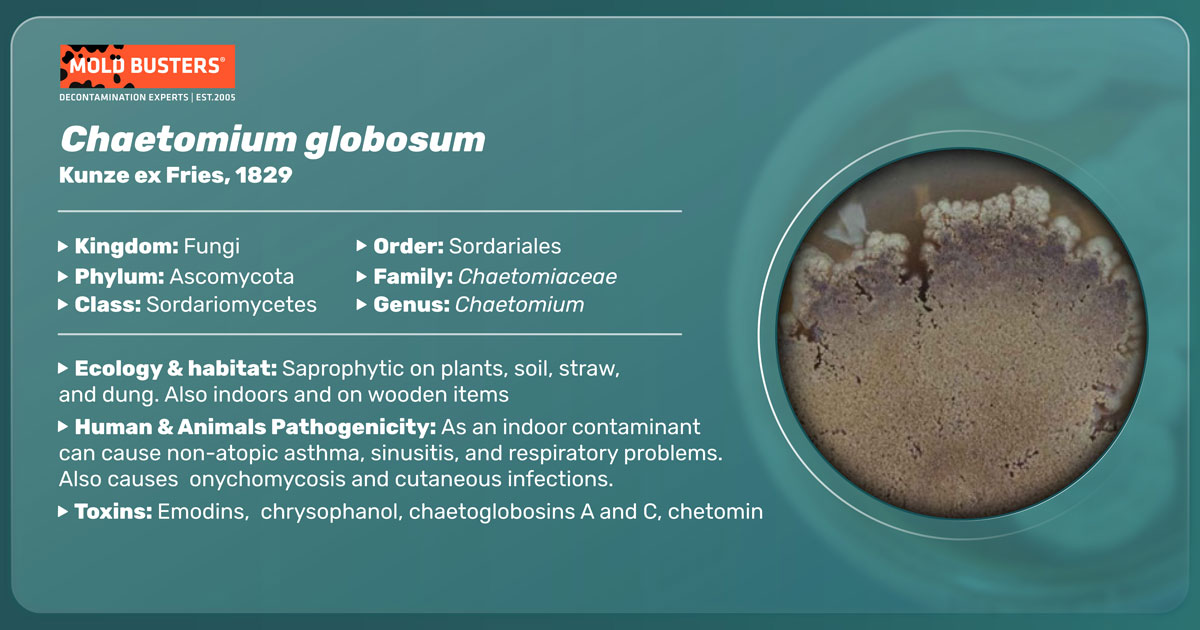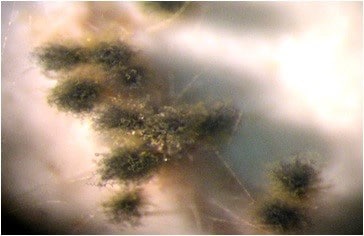Kunze ex Fries, 1829
What is Chaetomium globosum?
Chaetomium globosum is the most commonly found species of the genus Chaetomium [1], which belongs to the family Chaetomiaceae, order Sordiales, and division of Ascomycota. It was originally described by Gustav Kunze in 1817 [2,3].

As a widespread cellulolytic and endophytic fungus, it was found on different substrates: soil, air marine environments [1,4], on various crops, particularly wheat, barley, rice, beans, and soybeans [5]. C. globosum is one of the most common fungi isolated from damp building materials, especially on wallboard, solid wood, textiles, manufactured wood, ceiling tiles, and frequently found on insulation [6].
Chaetomium globosum produces a number of toxins: chaetoglobsins A, C and F [6,7], chaetoviridin A, chaetomugilin D, chetomin [6], and cochliodones [8]. On the other hand, it produces other secondary metabolites with a great potential for biological control that could be implemented in the agricultural, medicinal, and industrial fields [1,7]. In damp materials, they may evolve as the dominant fungal colonizers [9].
How does Chaetomium globosum look like?
Chaetomium globosum forms a sparse white colony that becomes grayish or olive when sporulate, precisely when it forms black reproductive structures called perithecia. Inside of perithecia, asci were formed with plenty of spheroidal to ellipsoidal or apiculate ascospores. Chaetomium globosum generally does not produce asexual spores. Colony reverse is tan to red or brown to black (Fig.1) [4,5].

Conditions for Chaetomium globosum growth
This species is well adapted to different environmental conditions, but it flourishes on temperatures between 24 and 38°C (75°F to 100°F), on alkaline media (with pH 7.1 -10.4) with plenty of moisture (Aw > 0.9). It can tolerate a temperature range from 4°C, pH from 3.5 to 11 [5,10], and a higher concentration of salts [3]. C. globosum cannot survive prolonged exposure to 55-57°C [10].
How to recognize Chaetomium globosum mold?
Being a cellulolytic fungus, Chaetomium globosum be found, causing discoloration on old books and similar artifacts or textiles [3]. On paper, it produces characteristic yellow-grayish-brown stains [11]. It is also found on different building materials containing cellulose, such as timber and plywood, or synthetic building materials, such as plastics. If conditions are favorable, it forms dense mycelia on a large area and degrades it in time, affecting materials structure [9].
What are adverse effects of Chaetomium globosum?
C. globosum is a common contaminant in indoor environments. It has adverse effects on human health due to the production of mycotoxins, volatile compounds, and airborne fungal fragments or ascospores. When those volatiles or fungal fragments are inhaled, they may contribute to the development of rhinitis or asthma symptoms [1]. It acts as an allergen, produces mycotoxins, and usually causes skin and nail infections. It rarely causes cerebral and systemic infections [4], can also contaminate dialysis fluid [3]. As with any other fungi, safe levels are considered less than 500 spores/m3[12].
Chaetomium globosum toxicity
Some secondary metabolites of Chaetomium globosum have toxic properties: chaetoglobosin A has low toxicity to mice, while chetomin is moderately toxic to rats [6]. Both chaetoglobosins and chetomins are highly cytotoxic, affecting cell division, locomotion, formation of cell surface projections, and glucose transport [4]. C. globosum hyphae and the spores contain antigens such as Chg45 that induce the production of IgE and IgG antibodies in allergic individuals. This can lead to non-atopic asthma, sinusitis, and respiratory illnesses [6].
Chaetomium globosum benefits
In medical research, various compounds produced by Chaetomium globosum exhibited helpful effects, such as chaetoglobosin X, which displayed antifungal reactions against a wide range of fungi and displays a strong cytotoxic activity against some cancer cell lines. Chaetoglobosin Y is cytotoxic to colon cancer cell lines. Other potential anticancer compounds from C. globosum are methyl 9-dihydro-8-trihydroxy-9-oxohxanthene-1-carboxylate and (E)-methyl 2-hydroxy-6, 6-dimethyl hept-3-enoate.
Agricultural research revealed that C. globosum exhibits insecticidal, fungicidal, and plant growth-promoting activity. C. globosum can have adverse effects on different pests, such as cotton aphids, beet armyworms, and root-knot nematode, and thus shows potential to be used as a biological agent [4].

Did you know?
Basements in Canada are the most affected by the Penicillium/Aspergillus mold group?! Find out more exciting mold stats and facts inside our mold statistics page.
References
- Wang XW, Lombard L, Groenewald JZ, Li J, Videira SIR, Samson RA, Liu XZ, Crous PW (2016). Phylogenetic reassessment of the Chaetomium globosum species complex. Persoonia, 36: 83–133.
- Retrieved from NCBI database ncbi.nlm.nih.gov/Taxonomy/Browser/wwwtax.cgi
- Biles CL, Wright D, Fuego M, Guinn G, Cluck T, Young J, Martin M, Biles J, Poudyal S (2012). Differential Chlorate Inhibition of Chaetomium globosum Germination, Hyphal Growth, and Perithecia Synthesis. Mycopathologia, 174:475–487.
- Sahu S, Prakash A (2018). Chaetomium globosum: A potential fungus for plant and human health. KAVAKA 50: 53-63
- Pitt JI, Hocking AD (2009). Fungi and food spoilage. New York, NY: Springer, pp 72,73.
- McMullin DR, Sumarah MW, Miller JD (2013). Chaetoglobosins and azaphilones produced by Canadian strains of Chaetomium globosum isolated from the indoor environment. Mycotoxin Research, 29:47–54.
- Fogle MR, Douglas DR, Jumper CA, Straus DC (2007). Growth and mycotoxin production by Chaetomium globosum. Mycopathologia, 164:49–56.
- Došen I, Nielsen KF, Clausen G, Andersen B (2017). Potentially harmful secondary metabolites produced by indoor Chaetomium species on artificially and naturally contaminated building materials. Indoor air, 27 (1): 34-46.
- Salo JM, Kedves O, Mikkola R, Kredics L, Andersson MA, Kurnitski J, Salonen H (2020). Detection of Chaetomium globosum, cochliodes, and Ch. rectangulare during the Diversity Tracking of Mycotoxin-Producing Chaetomium-like Isolates Obtained in Buildings in Finland. Toxins, 12(7):443.
- Retrieved from inspq.qc.ca
- Szczepanowska H, Lovett CM (1992). A study of the removal and prevention of fungal stains on paper. Journal of The American Institute for Conservation, 31 (2): 147-160.
- Retrieved from consumermoldguide.org)
- Abdel‐Kareem O (2010). Monitoring, Controlling and Prevention of the Fungal Deterioration of Textile Artifacts in the Museum of Jordanian Heritage. Mediterranean Archaeology and Archaeometry, 10 (2): 85‐96
- Figure featured image, retrieved from: adriancartermycology.ca

Get Special Gift: Industry-Standard Mold Removal Guidelines
Download the industry-standard guidelines that Mold Busters use in their own mold removal services, including news, tips and special offers:

Written by:
Aleksandra Zebeljan
Mycologist
Mold Busters
Edited by:
Dusan Sadikovic
Mycologist – MSc, PhD
Mold Busters
